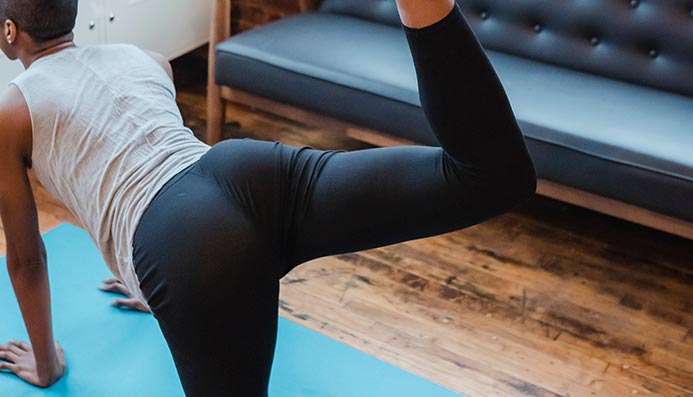Cable glute kickbacks are a great exercise to build and strengthen your glutes in a short span of time. In this article, you will understand how cable glutes kickback builds your legs, what muscles groups this targets, and the type of variations.
Let’s check it out…
Cable glute kickbacks
The cable glute kickbacks is a glute isolation exercise, that primarily focuses on strengthening your glutes muscles. This is an improvement to squats and lunges exercise, as this exercise increases the pelvis’s stability, balanced core training, and targets every glute muscle, which is hard to target in squats and lunges.
Although, glute kickbacks can be performed with bodyweight, bands, cable machines. The efficient way is to use a cable pulley machine, as you have full control over the resistance and it’s quicker and safer to use.
Muscles Worked By The Cable Glute Kickback
Cable Glute Kickbacks is one of the greatest exercises to target glutes and other leg muscles. It is an effective way to boost your overall performance, at this target quads, hamstring, and core.
Primary Muscle Groups: Gluteal Muscles
The gluteal muscles include the gluteus maximus, medius, and minimus, which are the strongest leg muscles in the body. The cable glute kickbacks primarily target this muscle by creating tension with a movement motion.
Secondary Muscle Groups: Hamstrings
Hamstrings are also engaged in this exercise, because of the movement of the entire leg, while keeping your upper body constant. This increases stability, balance, and endurance and strengthens core muscles.
Cable Glute kickback benefits
Besides performing the same leg exercise routine containing mainly squats and lunges, lifters can opt for efficient exercise to build stronger glutes. Cable glute kickbacks are good leg exercise that isolates the glutes and targets the muscles which squats and lunges could not target. Let’s check out, how cable glute kickbacks can benefit you:-
-
Strength Gains
For Stronger lower body strength, you need to build stronger glutes, as this will cause a serious benefit to your overall workout performance – it will boost deadlift, squats, elevate stability, and increase balancing power.
Adding a cable glute kickback exercise to your training routine will strengthen your glutes, and build your core.
-
Glute Isolation
Squats and lunges only target specific muscles, but cable glute kickbacks target small glute muscles and are not easily targeted. Due to this nature, overall glute muscles are used during the exercise and thus provide better muscle growth.
Cable glute kickback exercise mainly targets the gluteal muscles. This is one reason why glute kickbacks are better than squats and lunges.
-
Increased Balance & Stability
While performing the cable glute kickbacks, the lifter activates the glutes, core muscles, and also includes the ankle, calves, and quads.
This exercise increases muscle-mind connection, by improving your senses and modifying your senses ability, thus improving your stability and body control.
-
Mimics Real-life Movement
Unlike other leg exercises, like squats or lunges, this exercise follows the same movement pattern as a normal person does, in his entire day. The leg muscles which a person uses in his entire day by walking, running, stair climbing, or jumping, are targeted by cable glute kickbacks. Training these muscles with a similar real-life movement, helps you achieve greater results in your everyday life. Performing this exercise in your daily routine will make your daily life a lot easier.
-
Eases lower back pain
Lots of people suffer from back pain, due to long hours of sitting or weak glute muscles. Cable kickbacks can help you get rid of this lower back pain. Although you can not feel the difference right away, after consequently performing this training exercise, you can build and strengthen your glutes muscles, and also remove the back muscle stiffness.
-
Improved posture
Cable glute kickbacks are a great exercise to strengthen your leg muscles, but it also engages your hips, lower back, and other leg muscles. This leg exercise improves the person’s posture, by aligning hips, spine, and other leg muscles.
Why use a cable machine for glute kickbacks?
Cable machines make it easiest to perform the glute kickbacks. It allows the adjustable feature, where the lifter can change its resistance according to its capacity, and also getting into the position is way easier. In addition, the cable machine allows you to avoid any leg injury during exercise.
How To Do The Cable Glute Kickback
Equipment:
For cable glute kickback, you require a cable pulley machine and an ankle cuff attachment.
Setup:
- Set the cable pulley at the lowest position and attach the ankle cuff.
- Stand in front of the cable machine, and keep your feet apart Note: Don’t bend your knees throughout the exercise.
- Choose the cable glute kickbacks variations. ( 3 variations available).
- Choose appropriate weight, and according to fitness level.
Action:
- Stand in front of the cable machine, and keep your body uptight.
- Keep one leg straight, and engage abs, core, and glutes to move the other leg backward.
- Move your leg in a straight line, and avoid moving it sideways.
- Squeeze your glute during the entry exercise, and hold the leg at the peak position.
- Slowly go back to the original position without using momentum.
- Repeat the exercise for both legs.
Cable glute kickbacks Sets and Reps :
For beginners, the cable glute kickbacks can be slightly difficult, as some people find it hard to get to the perfect form.
Start by training with 3-4 sets of 12-15 repetitions.
Advanced lifters can opt for heavier weight, as you have full grasp and control over your exercise form. Thus aim for 3 sets of 7-8 repetition of heavier sets.
Or you modify this to increase the weight after the set.
People also ask : Does squeezing buttocks make it bigger ?
Cable Glute Kickback Mistakes
Although, the technique of the cable glute kickbacks is easy, while doing this exercise, make sure to avoid these mistakes. If you are making these mistakes, you’ll end up ruining the perfect form of the exercise, and will not target the specific muscle.
-
Using Leg Momentum
This is glute exercise, and if you are using your leg muscle to push it backward, you are receiving tension from the glutes. Generally, beginners do this exercise by swinging their legs and creating momentum during the exercise.
There is two reasons, you are doing this: either you are unaware of the technique, or you are using heavyweight in the exercise. The primary goal of the exercise is to squeeze your glutes and take control of their motion.
-
Less range of motion
The key aspect of this exercise is to follow a full range of motion through the exercise. This engages glutes and core, and the results are phenomenal. Make sure to extend your leg as backward as you can while keeping your back straight.
-
Standing Up Straight
Most people often stand straight while doing this exercise, which is one of the biggest mistakes you can make while doing cable glute kickbacks. If you stand straight, you limit the range of the glutes, and not all your glutes muscles are targeted. Slightly lean forward, as this will allow more leg extension and better exercise form.
-
Using the Wrong Weights
Choosing the weight is a personal preference, some people go for 8 reps with heavier weights and others perform 12-15 reps with lighter weight.
However, this exercise doesn’t require heavy weight, as this is a movement exercise, and increasing weights reduces the range of motion. So, instead of choosing heavyweight, opt for a lightweight set with 12-15 reps.
In addition, using heavyweight in the exercise, causes the lifter to swing the leg muscle, which ultimately risks proper form.
Cable Glute Kickback Variations
There are three variations of the cable glute kickback exercise. Each variation provides a different range of motion. From a small range motion for a strict posture exercise to a large range of motion, to give excessive mobility during exercise, you can choose as per your requirement.
The first variation is a Standing cable glute kickback, which has a small range of motion ( no knee extension), the second variation is a slightly bent over position, which has a slight knee extension. And the last is a kneeling cable kickback, which has the full range of motion.
1. Standing Cable Glute Kickback Technique (Hip Extension)
Steps:
- Set the cable pulley to the lowest position, and attach the ankle strap.
- Keep your feet apart, and face towards the machine, while holding the stand with one hand.
- Keep your body upright, straighten your leg, and raise it backward, without using momentum.
- Raise your leg behind, as far as possible, Without creating an arch of the spine. Hold at the peak position for 2 seconds, and slowly lower your leg back down.
2. Bent-Over Standing Kickback
Steps:
- Begin by standing near the cable pulley machine, and attaching the ankle strap to the machine.
- Set the machine to the lowest position.
- Face towards the machine and keep your feet apart.
- Create a slight bend by pushing your hips backward and your upper body forward.
- The angle should be 60° degrees for your upper body to the floor.
- Reminder: glutes are hip extensors and have full control over hip extension.
- This position allows you more room for hip movement, as compared to standing cable glute kickbacks.
- Push your hips backward and extend your leg straight back.
- Push until your leg is straight to the upper body.
- Hold the position for 2 seconds and go back to the original position.
3. Kneeling Cable Kickbacks Technique
Steps:
- This is one of the best cable glute kickbacks variations as it allows a full hip range of motion.
- Grab a flat bench and place it in front of the cable machine.
- Keep the pulley to the lowest position, and attach the ankle strap.
- Hold the bench with both hands, and this creates your upper body parallel to the floor.
- Push your leg back without bending the knee, and keep pushing until it reaches the parallel with the surface.
- This will fully extend your hips, and train your glute muscle faster. Hold the position for 2 seconds and get back to the original position.










